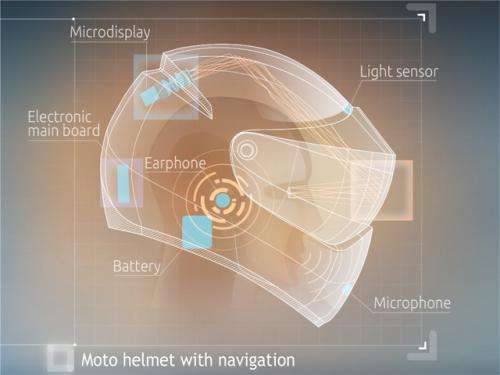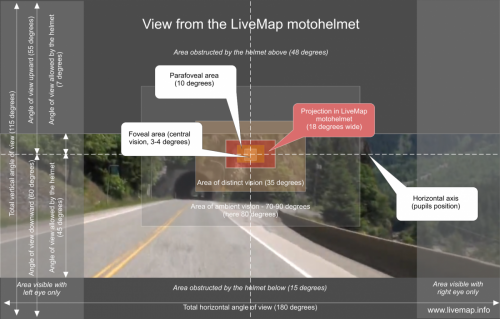An Android-based motorcycle helmet with GPS and voice-control has won the confidence of project supporters. The company is preparing to roll out its creation next year. Russian startup Livemap is behind this tech helmet with its built-in navigation.
TechCrunch reported the company received a grant of 14.7 million rubles from the Russian Ministry of Science towards the development of their navigating devices. The helmet's advantages revolve around ease of use and road safety. Because of the helmet's features and design, the driver need not take eyes off the road. GPS navigation is directly in the field of vision. The rider's view is in a helmet display—no need to touch any other device. The helmet is slightly bigger than the average helmet so that the picture can be projected on to the visor. A microphone for voice control keeps both hands free for driving.
A YouTube video about the helmet features a narrator, an IT specialist, with a British accent, on his motorbike, set to ride around in Moscow and trying to find his way. He notes the difficulties in doing so when one neither knows spoken nor written Russian. Besides, in riding around, he said, one does not have time to read the names of the streets. You need to stop and look at a map. As for local residents, he said, what about asking them for help? He said little is understood; it adds up to the foreign rider just looking at people pointing in the air and waving their arms. That, he said, is why he ended up getting a GPS but he had to look down and stop, to sort out a missed voice notification. It's just not safe, he said, especially in Russia (the video is intended to make you smile) where, he said, anything can happen. That is when the screen shows a series of such yikes-inducing scenes as a tank flying across the street.
Their final helmet version will be made out of carbon fiber—a high-strength material stronger than steel. At the same time, this material is light; it will weigh about 1.4 kg. They said the helmet will be certificated by international standards: USA DOT, European ECE 22.05, Japanese JIS T 8133 and FCC. Usability expert Dmitry Sozonov said the team tried to make their interfaces simple; the rider sees the interface and the road at the same time. This is a "minimalistic interface." They said, "you will not be able to play games or watch video on the go, sorry!" The picture is full-color, translucent, projected right on the visor. The picture changes according to the view direction. According to the video, the helmet will be providing maps for all countries in the world. What's more, it will provide information on the weather, points of interest as well as traffic conditions.
Turning to comments about the helmet's voice control, George Manukyan, software engineer, said the company did several tests in various noisy conditions and the results were quite good. The recognition coefficient level is up to 95 percent. Just as the visual interface is to be minimalistic, the list of voice commands will also be kept simple, as they will be short, with all commands natural and understandable by context.
Will the team roll out the final product soon? In a December update, Anthony Ha of TechCrunch said he got an email from Livemap CEO Andrew Artischev, telling Ha that most of the past year has been spent building the pre-production prototype of Livemap's optics. Ha said "Those optics will be built entirely of aspheric lenses, allowing the helmet to, in his words, be 'smaller and lighter and sometimes cheaper than the multi-lens design.' He added that the other big focus has been creating a design that will keep the optics costs down."
The price will be $2,000 but they are currently offering a special pre-order price at $1,500. Ha reported that Livemap plans to unveil a prototype in the spring and to start sales this summer in its first market, the United States.
More information: livemap.info/
© 2014 Tech Xplore























